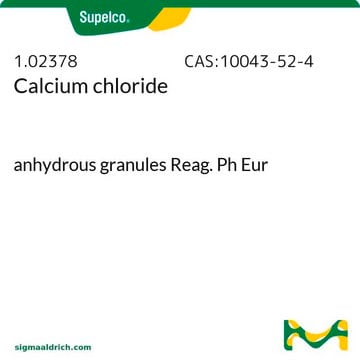Products may be shipped at a different temperature than the recommended long-term storage temperature. If the product quality is sensitive to short-term exposure to conditions other than the recommended long-term storage, it will be shipped on wet or dry-ice. If the product quality is NOT affected by short-term exposure to conditions other than the recommended long-term storage, it will be shipped at ambient temperature. As shipping routes are configured for minimum transit times, shipping at ambient temperature helps control shipping costs for our customers. For more information, please refer to the Storage and Transport Conditions document: https://www.sigmaaldrich.com/deepweb/assets/sigmaaldrich/marketing/global/documents/316/622/storage-transport-conditions-mk.pdf
C5670
Cloruro di calcio
anhydrous, BioReagent, suitable for insect cell culture, suitable for plant cell culture, ≥96.0%
Sinonimo/i:
CaCl2, Calcium dichloride
Scegli un formato
Scegli un formato
About This Item
Prodotti consigliati
Grado
anhydrous
Tensione di vapore
0.01 mmHg ( 20 °C)
Nome Commerciale
BioReagent
Saggio
≥96.0%
Stato
powder
tecniche
cell culture | insect: suitable
cell culture | plant: suitable
Punto di fusione
772 °C (lit.)
Stringa SMILE
[Cl-].[Cl-].[Ca++]
InChI
1S/Ca.2ClH/h;2*1H/q+2;;/p-2
UXVMQQNJUSDDNG-UHFFFAOYSA-L
Cerchi prodotti simili? Visita Guida al confronto tra prodotti
Descrizione generale
Applicazioni
transfection of eukaryotic cells with either plasmid DNA or high molecular weight genomic DNA. The CaCl2-mediated electroporation of E. coli with the plasmid DNA pBR322 has been studied. A protocol for the concentration of virus vectors that uses CaCl2 has been published.
Nota sulla preparazione
Avvertenze
Warning
Indicazioni di pericolo
Consigli di prudenza
Classi di pericolo
Eye Irrit. 2
Codice della classe di stoccaggio
13 - Non Combustible Solids
Classe di pericolosità dell'acqua (WGK)
WGK 1
Punto d’infiammabilità (°F)
Not applicable
Punto d’infiammabilità (°C)
Not applicable
Scegli una delle versioni più recenti:
Certificati d'analisi (COA)
Non trovi la versione di tuo interesse?
Se hai bisogno di una versione specifica, puoi cercare il certificato tramite il numero di lotto.
Possiedi già questo prodotto?
I documenti relativi ai prodotti acquistati recentemente sono disponibili nell’Archivio dei documenti.
I clienti hanno visto anche
Articoli
Calcium is an ionically stable divalent cation with important beneficial and toxic properties in cell culture. It is a component of a wide range of cell culture media.
-
How is shipping temperature determined? And how is it related to the product storage temperature?
1 answer-
Helpful?
-
-
How can I determine the shelf life / expiration / retest date of this product?
1 answer-
If this product has an expiration or retest date, it will be shown on the Certificate of Analysis (COA, CofA). If there is no retest or expiration date listed on the product's COA, we do not have suitable stability data to determine a shelf life. For these products, the only date on the COA will be the release date; a retest, expiration, or use-by-date will not be displayed.
For all products, we recommend handling per defined conditions as printed in our product literature and website product descriptions. We recommend that products should be routinely inspected by customers to ensure they perform as expected.
For products without retest or expiration dates, our standard warranty of 1 year from the date of shipment is applicable.
For more information, please refer to the Product Dating Information document: https://www.sigmaaldrich.com/deepweb/assets/sigmaaldrich/marketing/global/documents/449/386/product-dating-information-mk.pdfHelpful?
-
-
What is the procedure for preparing a 2 M solution using calcium chloride and calcium chloride dihydrate?
1 answer-
The molecular weight for calcium chloride dihydrate is 147.01 g/mol, so a 2 M solution would be 294 g/L. Similarly, the molecular weight for calcium chloride is 110.98 g/mole, so a 2 M solution would be 222 g/L. Therefore, a 2 M solution of calcium chloride dihydrate (such as C7902) would be 294 g/L with a molecular weight of 147.01 g/mol.
Helpful?
-
Active Filters
Il team dei nostri ricercatori vanta grande esperienza in tutte le aree della ricerca quali Life Science, scienza dei materiali, sintesi chimica, cromatografia, discipline analitiche, ecc..
Contatta l'Assistenza Tecnica.











